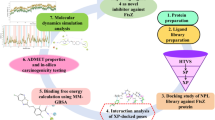Abstract
Eleven 1,4-naphthoquinone analogues with different amino substitutions at position 3 of the quinone ring earlier reported for macrofilaricidal activity were selected and screened against purified cytosolic GST isolated from the bovine filarial worm Setaria digitata and IC50 values were determined. Of the 11 compounds tested, 8 showed good inhibition against S. digitata GST. The IC50 values of the most effective macrofilaricidal compounds—11 [2-(4-methylpiperazin-1-yl)naphthalene-1,4-dione] and 9 {2-[(1,3-dimethylbutyl)amino]naphthalene -1,4-dione}—were 0.872 and 0.994 mM, respectively. Compounds 9 and 11 were further studied for type of enzyme inhibition and found to exhibit competitive and uncompetitive inhibition kinetics, respectively, with respect to substrate GSH. All 11 compounds were in agreement with Lipinski’s rule of five and passed through the FAFDrugs ADME/tox filter. Molecular docking was carried out using the modeled 3D structure of wbGST PDB ID:1SFM as receptor and substituted naphthoquinones as ligands using AutoDock 4.0. The binding energy of nine compounds varied from −9.15 to −6.58 Kcal mol−1, whereas compounds 8 and 10 did not show any binding to the receptor. Among the compounds studied, compound 7 {2-[3-(diethylamino) propyl]aminonaphthalene-1,4-dione} showed maximum affinity towards wbGST as it exhibited the lowest binding energy, followed by compounds 11 and 9. However compound 7 was not macrofilaricidal while 11 and 9 exhibited macrofilaricidal activity. The results of in silico and in vitro studies with the synthesized 1,4 -naphthoquinone analogues on filarial GST and in vitro macrofilaricidal activity against adult bovine filarial worm S. digitata open up a promising biochemical target for antifilarial drug development.





Similar content being viewed by others
References
WHO (2007) Wkly Epidemiol Rec 82:361–380
Michael E, Bundy DAP (1997) Parasitol Today 13:472–476
Otteson EA (1994) Curr Opin Infect Dis 7:550–558
Tiwari VK, Tewari N, Katiyar D, Tripathi RP, Arora K, Gupta S, Ahmad R, Srivastava AK, Khan MA, Murthy PK, Walter RD (2003) Bioorg Med Chem 11:1789–1800
Precious WY, Barret J (1989) Biochim Biophys Acta 992:215–222
Callahan HL, Crouch RK, James ER (1988) Parasitol Today 4:218–225
Brophy PM, Pritchard DI (1992) Parasitol Today 8:419–422
Brophy PM, Barret J (1990) Parasitology 100:345–349
Liebau E, Wildenburg G, Brophy PM, Walter RD, Henkle-Dührsen K (1996) Mol Biochem Parasitol 80:27–39
Brophy PM, Pritchard DI (1994) Exp Parasitol 79:89–96
Sharp PJ, Smith DRJ, Bach W, Wagland BM, Cobon GS (1991) Int J Parasitol 21:839–846
Van Bladeren PJ, van Ommen B (1991) Pharmacol Ther 51:35–66
Nathan ST, Nisha M, Kalyanasundaram M, Balaraman K (2005) J Mol Model 1:194–199
Kaushal NA, Kaushal DC, Ghatac S (1987) Immunol Invest 16:139–149
Lakshmy S, Nisha M, Kalyanasundaram M (2009) Parasitol Res 105:1179–1182
Mukhopadhyay S, Dash AP, Ravindran B (1996) Parasitology 113:323–330
Nisha M, Twinkle K, Lakshmy S, Kalyanasundaram M (2010) Drug Dev Res 71:188–196
Habig WH, Pabst MJ, Jakoby WB (1974) J Biol Chem 249:7130–7139
Miteva MA, Violas S, Montes M, Gomez D, Tuffery P, Villoutreix BO (2006) Nucleic Acids Res 34:W738–W744
Huey R, Morris GM, Olson AJ, Goodsell DS (2007) J Comput Chem 28:1145–1152
AutoDock Tools [http://autodock.scripps.edu/resources/adt/index_html
Johansson A, Ridderstrom M, Mannervik B (2000) Mol Pharmacol 57:619–624
Hiller N, Fritz-Wolf K, Deponte M, Wende W, Zimmermann H, Becker K (2006) Protein Sci 15:281–289
James ER (1994) Parasitol Today 10:481–482
Selkirk ME, Smith VP, Thomas GR, Gounaris K (1998) Int J Parasitol 28:1315–1332
Nisha M, Kalyanasundaram M (2007) Expert Opin Ther Pat 17:767–789
Waterbeemd H, Gifford H (2003) Nat Rev Drug Discov 2:192–205
Lipinski CA, Lombardo F, Dominy BW, Feeney PJ (2001) Adv Drug Deliv Rev 46:3–26
Daniel FV, Stephen RJ, Hung-Yuan C, Brian RS, Keith WW, Kenneth DK (2002) J Med Chem 45:2615–2623
Guyton AC (1991) Textbook of medical physiology, 8th edn. Saunders, Philadelphia, pp 683–684
Michele AM, DeWight RW, John AT (1995) J Mol Biol 246:21–27
Harwaldt P, Rahlfs S, Becker K (2002) Biol Chem 383:821–830
Acknowledgments
N.M. expresses sincere gratitude to the Department of Science and Technology (DST), Government of India for funding [Grant SR/SO/HS-83/2005] to conduct this study. The authors are grateful to Dr. P. Jambulingam, Director, Vector Control Research Center, Pondicherry, for his encouragement during the study. The technical assistance of Mrs. Anila Kumari and Mr. Srinivasan is also acknowledged.
Author information
Authors and Affiliations
Corresponding author
Supplementary material available
Below is the link to the electronic supplementary material.
ESM 1
Docking binding energy (mean lowest) values and the number of members of each cluster (DOC 117 kb)
Rights and permissions
About this article
Cite this article
Mathew, N., Srinivasan, L., Karunan, T. et al. Studies on filarial GST as a target for antifilarial drug development—in silico and in vitro inhibition of filarial GST by substituted 1,4-naphthoquinones. J Mol Model 17, 2651–2657 (2011). https://doi.org/10.1007/s00894-010-0952-9
Received:
Accepted:
Published:
Issue Date:
DOI: https://doi.org/10.1007/s00894-010-0952-9




